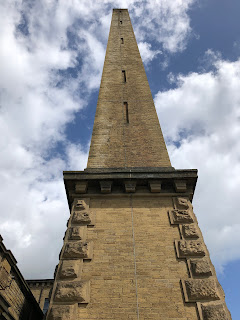Industrial Scale Art and Heritage at Saltaire
In Brief.
 |
| The chimney at Salts Mill |
What's Here?
The intimidating scale of the mill is diluted on entry to the ground floor 1853 Gallery, which hosts the world's largest permanent collection of David Hockney's work. This all sounds quite serious, but it is a decidedly unpretentious space, which the artworks share with art supplies and books for sale on tables in the middle. The David Hockney works here include portraits and assorted representations of swimming pools.
 |
| The 1853 Gallery |
Other floors include a variety of retail, art and eating spaces. This is in contrast with a typical art gallery layout, with a shop and cafe at the entrance, and then the art all together, but perhaps follows from the idea that this should be a destination for a varied day out. As well as the ground floor, there is a further series of David Hockney paintings on The Arrival of Spring, and a perhaps temporary frieze on A Year in Normandy. Both were produced using an iPad instead of traditional media, though you would be hard pressed to tell, and do seem to be capturing rural scenes in the moment.
In between all this, without leaving the mill, you may find yourself in a cafe or a shop; in the huge spaces of the mill, there is a good bookshop that also sells David Hockney prints and a household goods shop; shopping isn't really my thing, but both of these had plenty interesting stock, well displayed. There is also a leisure clothes shop, though without quite such a grand space.
Some background on the industrial heritage of the mill is provided through a film and exhibition; this is much less comprehensive than Quarry Bank, but does give a flavour of the scale of the manufacturing activity that must now largely be overseas. For further industrial heritage, the model village built for the mill workers is well preserved adjacent to the mill, and there are boat trips along the canal beside the park. For the shopping enthusiast, the village also has an eclectic range of independent shops.
Practicalities.
Distance from Manchester Town Hall: 44 miles
Drive Time: 65 minutes.
Price: Free
Parking: Free onsite parking is included at Salts Mill. Note that the village is at the opposite side of the mill to the parking.
Food and Drink: There are two cafes, in Salts Mill, one in the park and several in the village. For lunch, I had a tasty Kedgeree in the Salts Diner, and afternoon coffee with a view in Roberts Park.
Retail therapy: There are lots of, generally quite up-market, shopping opportunities in the mill itself and in the village.
Child Friendly: There are lots of art supplies on sale in the 1853 Gallery, and there is a play area adjacent to Roberts park.
Toilets: Yes - throughout the mill.
Do it justice in: 3 hours.
Inside-Outside: 70:30



Comments
Post a Comment